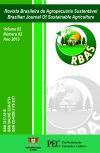EFEITO DO SILÍCIO, NITROGÊNIO E POTÁSSIO NA PRODUÇÃO DE TOMATE INDUSTRIAL
DOI:
https://doi.org/10.21206/rbas.v3i2.223Resumen
O tomate ocupa o segundo lugar entre as hortaliças na ordem de importância econômica. O objetivo deste trabalho foi verificar o efeito do silício, nitrogênio e potássio na produtividade de tomate industrial. O experimento foi conduzido na FAL-UnB, em delineamento inteiramente casualizado, com 14 formas de adubação (Testemunha - sem adubação; 2, 4, 6 e 8 kg.ha-1 de SiO2; 60, 120, 180 e 240 kg.ha-1 de nitrogênio; 100, 200, 300 e 400 kg.ha-1 de K2O; e NPK conforme análise do solo), três genótipos (Viradoro, Tospodoro e HEI O35) e duas diferentes épocas de avaliação/colheita, totalizando 84 tratamentos, em quatro repetições, em um total de 336 parcelas experimentais. Para avaliação da produtividade e classificação dos frutos utilizouse norma do MAPA. Foi observado que a menor dose de cada adubo proporcionou maior produção de frutos adequados ao processamento. O genótipo HEI 035 apresentou menor número de frutos descoloridos e brocados, diferindo estatisticamente dos resultados observados nos demais genótipos. Porém, HEI 035 apresentou maior número de frutos com coração preto, diferindo estatisticamente de Tospodoro que apresentou o menor valor. Foi observado maior número de frutos com rachadura nas menores doses de Si, N e K que não diferiu estatisticamente da testemunha, mas diferiu do tratamento NPK que apresentou o menor número de frutos rachados. HEI 035 apresentou o maior número de frutos com fundo preto. Conclui-se que a menor dose de cada fertilizante (silício, nitrogênio e potássio) propicia maior produção de frutos adequados ao processamento.Descargas
Descargas
Publicado
2013-12-30
Cómo citar
Ana Lúcia Hanisch2, José Alfredo da Fonseca2, Alvadi Antonio Balbinot Junior3, & Evandro Spagnollo4. (2013). EFEITO DO SILÍCIO, NITROGÊNIO E POTÁSSIO NA PRODUÇÃO DE TOMATE INDUSTRIAL. Revista Brasileira De Agropecuária Sustentável, 3(2). https://doi.org/10.21206/rbas.v3i2.223
Número
Sección
Artigos
Licencia
1. Proposta de Política para Periódicos de Acesso Livre
Autores que publicam nesta revista concordam com os seguintes termos:
Autores mantém os direitos autorais e concedem à revista o direito de primeira publicação, com o trabalho simultaneamente licenciado sob a Licença Creative Commons Attribution que permite o compartilhamento do trabalho com reconhecimento da autoria e publicação inicial nesta revista.












